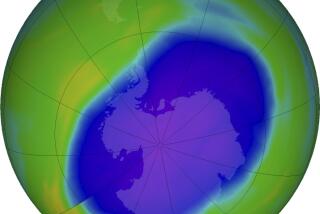Science / Medicine : Satellites Detect Ozone Hole
- Share via
Scientists have detected an ozone hole developing over the South Pole a month earlier than previously possible by using satellite methods that work without sunlight.
National Oceanic and Atmospheric Administration researchers said they used infrared data from two polar-orbiting satellites to examine ozone depletion over the Antarctic from Aug. 20 to Sept. 10.
Images produced from the satellite data show the area encompassed by the ozone hole grew larger over the three-week period. On Aug. 22, the hole appeared to cover about one-tenth of the Antarctic. By Sept. 10, the hole had grown to cover nearly the entire continent.
Scientists have believed that the seasonal depletion of the protective ozone layer started in late August, but that hunch had never been directly confirmed. Until now, the Antarctic ozone hole--which usually reaches its maximum size in October--could not be observed until about Sept. 20, when the pole’s brief season of daylight begins.





